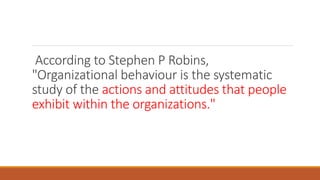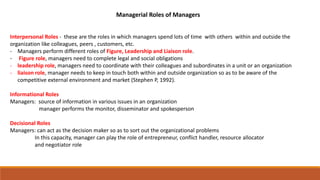Human behavior report
- 1. NATURE OF MANAGEMENT AND LEADERSHIP IN AN ORGANIZATION
- 2. Organization is the structural framework of duties and responsibilities required of personnel in performing various functions with a view to achieve business goals through organization. Management tries to combine various business activities to accomplish predetermined goals.
- 3. According to Stephen P Robins, "Organizational behaviour is the systematic study of the actions and attitudes that people exhibit within the organizations."
- 4. Organizational Management Management _ it is the planning and directing of effort and the organizing and employing of resources (both human and material) to accomplished some of the predetermined objective.
- 5. Identifying goals and objectives Stating premises and assumptions Developing specific, detailed plans • Breaking work done into components • Grouping related work activities and units • Defining authority relationship • Developing organization chart • Developing position descriptions Actuating/motivating • Communicating objectives to members • Leading members to objectives • Training and supervising • Integrating individuals into organizations Controlling • Measuring accomplishments Against stated goals • Correcting deviation from goals • Developing feedback mechanisms Concept of Organizational Management
- 6. Managerial Roles of Managers Interpersonal Roles - these are the roles in which managers spend lots of time with others within and outside the organization like colleagues, peers , customers, etc. - Managers perform different roles of Figure, Leadership and Liaison role. - Figure role, managers need to complete legal and social obligations - leadership role, managers need to coordinate with their colleagues and subordinates in a unit or an organization - liaison role, manager needs to keep in touch both within and outside organization so as to be aware of the competitive external environment and market (Stephen P, 1992). Informational Roles Managers: source of information in various issues in an organization manager performs the monitor, disseminator and spokesperson Decisional Roles Managers: can act as the decision maker so as to sort out the organizational problems In this capacity, manager can play the role of entrepreneur, conflict handler, resource allocator and negotiator role
- 7. Education leadership is possibly the most important single determinant of an effective learning environment. Change leaders must understand procedures and processes that create the conditions necessary for organizational improvement. Skilled leaders correctly envision future needs and empower others to share and implement that vision. Building principals must be able to assess and evaluate the impact and perceptions of their leadership styles.Fullan (2002) points out that "Only principals who are equipped to handle a complex, rapidly changing environment can implement the reforms that lead to sustained improvement in student achievement" (p. 16). Indeed, principals must deal with the various levels of skills and abilities of their faculty and a continuity of divergent situations within today's complex school environment. leadership style is the way a person uses power to lead other people. Research has identified a variety of leadership styles based on the number of followers. The most appropriate leadership style depends on the function of the leader, the followers and the situation.
- 8. Transactional leadership. Unlike the multi-faceted transformational leadership, transactional leadership is described as the one-dimensional exchange between leader and follower that serves to preserve the status quo. A transactional leader's role is in organizational maintenance, ensuring that the various units in the organization or department function in an integrated and coordinated manner. This style is less likely to be found in the context of effective school improvement (Leithwood et al., 1999). Emotional leadership. Transformational leadership affects feelings of trust, loyalty and enthusiasm in followers. This ability to engage members of a staff and bring them on board would be what Goleman, Boyatzis, and McKee (2002) call emotional intelligence. An emotionally intelligent leader cannot only "empathize with... emotions, but also expresses them for the group" (Goleman et al., p. 20). Effective emotional leadership engages followers' emotional centers, creating a mindset prepared for creative problem solving, optimism, flexibility and productivity.
- 9. Types of Leadership: Transformational leadership The philosophical foundation for this study is based in Leithwood, Jantzi and Steinbach's (1999) model of transformational leadership. From "setting direction" to "developing people" to "redesigning the organization“.
- 10. Maslow's Theory According to the Maslow theory of motivation, five essential needs are important for the motivation of human beings. A pyramid known as hierarchy of needs has been formed demonstrating the five essential needs (Maslow, 1949). Bottomof the pyramid shows basic needs like food and shelter that motivate people to work hard. People get the salaries and these needs are met. After these needs are satisfied, people look for their safety and security through good and safe job. Then comes the social needs like the need to belong to a group. Self esteemis the next need after social needs. Self-esteem is the need that can be satisfied with the recognition or the promotion. And the topmost need is the self-fulfilment. Self fulfilment means personal development, creativity and interests. If a person gets his need satisfied for one level then he gets motivated to the next level (Maslow, 1949).










